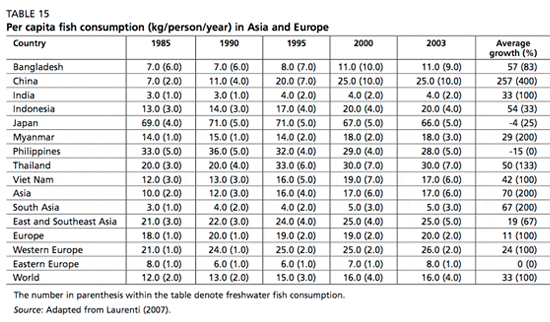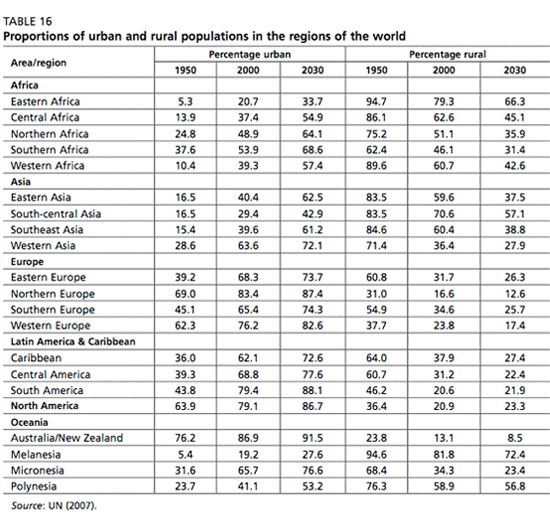During the 1990s, global apparent consumption of fish increased. The global average apparent per capita consumption increased from about 9 kg per year in the early 1960s to 16.3 kg in 1999 (WHO, 2002). The global per capita availability of fish and fishery products has, therefore, nearly doubled in 40 years, outpacing population growth. This development was heavily dominated by events in China, which emerged as the world’s largest fish producer during this period (Popkin, 2001). In fact, excluding China, the apparent consumption per person in the rest of the world actually declined from 14.4 kg in 1990 to 13.1 kg in 1999. However, it is important to note that such global figures mask the very wide differences among countries in the amount of fish used for food consumption (FAO, 2003) (Table 15).

In both Asia and Europe, the low proportion of freshwater fish in per capita fish consumption indicates the preference for marine (including brackishwater) fish. East and Southeast Asia, where aquaculture is growing fast, this trend is quite evident when fish consumption is compared with South Asia. A majority of the cultured marine species are high-value and depend on high-quality complete diets. Driving forces that influence consumer behaviour and lead to an increase in the demand for various types of fish and meat are urbanization, lifestyle and dietary habits (Popkin, 1999). The forces that influence fish consumption, however, may vary between developing and developed countries. Delgado (1999) pointed out that in developing countries, increasing income and urbanization would be the leading factors for the increasing demand for fish and meat by 2020 (Delgado et al., 2003). Lubchenco (2003) claimed that the increasing demand in developed countries is driven by increased consumer awareness of the health and nutritional benefits of seafood, increased standardization and availability of products and cheaper prices. The relationships between income and urbanization and fish consumption are clearly important factors to be taken into consideration in the calculation of future fish demand and type of fish as there is a trend in urbanization globally.
The increase in population between 2005 and 2030 is expected to be 1.7 billion. This increase will be primarily accounted for by the growth in the urban areas of less developed regions, which is expected to reach 3.9 billion from 2.3 billion in 2005 (UN, 2007). Unlike developing regions, developed regions had already attained high levels of urbanization by 1950 (Table 16). It is projected that similar levels of urbanization will take place in the developing world. Between 2000 and 2030, Asia’s urban population will increase from 1.36 billion to 2.64 billion, that of Africa from 294 million to 742 million, and that of Latin America and the Caribbean from 394 million to 609 million. As a result of these shifts, developing countries will have 80 percent of the world’s urban population in 2030 (UN, 2007). By then, Africa and Asia will host almost seven out of every ten urban inhabitants in the world. With urbanization, people are increasingly drawn towards urban settlements and as both the level and distribution of income changes, the pattern of fish demand will change, with important implications for the demand for fish, and, in turn, implications for the type of feed used.

Consumers are as diverse in their consumption preferences as the fish products they consume. The increasing demand in developed countries, where urbanization is high, has been mostly for high-value fish species. Thus, the demand for high-value species, which consume high-quality feeds, may increase in developing countries as urbanization increases. Although growth in all aquaculture sectors is increasing (see Section 1.2), it can already be seen that exceptionally high growth rates have occurred in the production of high- value and carnivorous species such as freshwater swamp eel, mandarin fish, channel catfish, red swamp crawfish and freshwater swamp eel.
The increasing supply of high-value species is associated with decreasing market price of high-value species. The decrease in market price of high-value species may be attributed to the promotion of intensive practices in recent years to increase production, development of complete commercial performance diets and the competitive market environment. For example, the rapidly increasing production of whiteleg shrimp has led to price depression in the international markets (FAO, 2006). Similarly, farm-gate value for 15–20 g size whiteleg shrimp has steadily decreased from US$5/kg in 2000 to about US$3.00–3.50/kg in 2005. The market prices of European seabass and gilthead seabream imported to Italy from Greece dropped from €7/kg in 1999 to €4.6/kg in 2007 and €6/kg in 1999 to €3.8/kg in 2007, respectively (Fish Site, 2007).
Further Reading
| - | You can view the full report by clicking here. |

